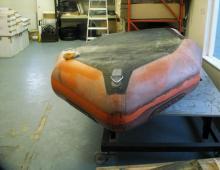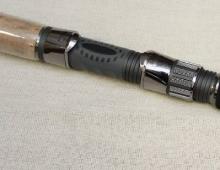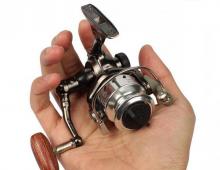Feeder equipment: diagrams and drawings of feeder equipment
How to properly assemble feeder tackle:
- It is necessary to assemble the feeder rod by connecting all its collapsible knees. This is the case when the spinning is composite. If it is telescopic, then you just need to expand it.
- Attach the feeder to the feeder rod.
- Having opened the darling of the line stacker, the fishing line is threaded through all the rings without exception. And it’s worth starting from the one closest to the reel, and ending with the one that is at the tip of the rod. After that, the douche closes.
- A loop is created at the tip of the fishing line with a figure-eight knot, to which the feeder equipment will be attached in the future using the loop-to-loop method. Feeder is ready!
Equipment for feeder "Paternoster"
Such equipment is best suited for bottom fishing for predators. This is typical for float fishing with the presence of a sinker and live bait on a branch leash. Whereas spinningists simply refer to this type of equipment as a “retractable leash”.
We knit paternoster
Paternoster Gartner (on two loops):
- At the end of the main line, create a loop to further secure the leash with the hook.
- After that, make a few turns around it (3-4).
- Moisten the knot and tighten it well.
- At a distance of 15 centimeters, create the same loop, but 5-8 cm long. Its dimensions should let the feeder inside.
- Already directly on fishing, the paternoster is passed through the feeder rings. A larger loop goes inside the swivel ring on the feeder.
- When tightening the loop, you need to make sure that it is not at one point, but is distributed throughout the swivel. Only this will allow you to quickly replace the feeder without breaking the loop.
- After inserting the loop into the loop, the leash with the hook is attached to the smaller loop. The rig is ready.
Advantages:
- ease of knitting;
- the possibility of overlap and entanglement is minimized;
- if you decide to fish in a pond with a muddy bottom, the leash will be located directly on the surface of the water and in the field of view of the fish;
- high sensitivity in the case of a well-placed leash after casting and reeling.
Flaws:
- since fishing in the course involves raising the leash above the bottom of the reservoir, it will become very noticeable to the fish, which can scare away;
- in the process of winding out, this type of equipment is very twisted.
Inline feeder equipment
- A silicone limiter is put on the main monofilament in the case of a fixed type of equipment.
- Thread the monofilament into the tube inside the feeder.
- Put on the damper.
- After creating a standard loop with a figure-eight knot, stretch the swivel to which the feeder will be fixed. To ensure a quick change of leashes, you can use a special connector. Feeder is ready!
Advantages:
- due to the location of the twist of the lead for the leash directly behind the feeder, the equipment is not so subject to entanglement during the casting process;
- if there is a stopper on the main monofilament in front of the feeder, the feeder can self-cut;
- after moving the stopper to the feeder, the equipment turns into a real methodological unit;
- even in the case when a long leash is wrapped around the main monofilament, the feeder will be able to provide a bite on the rig's whip.
Flaws:
- the difficulty lies in the process of mounting the equipment;
- to implement this type of feeder, you will need auxiliary materials: a bead and a needle for further piercing the cambric. It will not be so easy to make a snap directly on a fishing trip, although it is possible;
- without a stopper, it is impossible to implement self-cutting of fish;
- hooked on the feeder or breaking off the main monofilament, you will need to mount a new rig. Because the previous one will be corrupted;
- the leash, wound around the main monofilament, located in the middle of the stopper and the feeder, forever loses its sliding property, turning into a method version of the tackle.
Loop rigs
Asymmetrical loop
- Create a twist with the monofilament previously folded in half. Its length should be 15 cm.
- To further secure the feeder, insert the swivel with a clasp through the long side.
- After measuring the required length of the asymmetrical loop, tighten the knot. The rig is ready!
Advantages:
- provides maximum casting, both in standing water and in the current;
- such equipment practically minimized the possibility of overlapping the leash over the braid;
- high level of sensitivity.
Flaws:
- since this type of feeder rig is knitted from a thick monofilament, it will turn out to be noticeable to the fish, and can scare them away.
Symmetric loop

Advantages:
- you can easily create equipment directly on the fishing trip;
- no need to use additional elements for mounting the feeder;
- the shortest loop 2-3 cm long will turn the feeder into a method construction;
- if you correctly install the equipment, then the twist of the branch will always be directed away from the feeder, minimizing the possibility of entanglement during the casting process;
- even entangled, the feeder will transfer the bite to the snap whip;
- in the case of wrapping the leash around the loop, the feeder must retain its functionality.
Flaws:
- if the feeder is installed incorrectly, sensitivity will be lost and bite will be inaudible;
- when the feeder is hooked tightly, it will be necessary to completely replace the equipment;
- breaking off, the main monofilament will leave the hooked fish “on a leash”.
Feeder accessories with anti-twist
- To begin with, an anti-twist with stoppers is put on the main monofilament.
- Proceed to fasten the lower swivel and leash together with the hook.
- Attach the feeder to the carabiner.
- Moreover, direct the long end of the anti-twist towards the leash to eliminate the entanglement of the equipment. Feeder is ready!
Advantages:
- the likelihood of twisting the fishing line is minimized;
- ease of installation of the feeder;
- the feeder “holds” the bottom well, which involves the use of not very heavy weights;
- shows good sensitivity parameters;
- minimal chance of snapping.
Flaws:
- it is imperative to control the proportionality of the lengths of the leash tube, since the casting distance is reduced due to windage;
- such a feeder should not be used on a reservoir with a muddy and soft bottom.
Helicopter
- After putting the stopper on the fishing line, it is necessary to bring the swivel through it and fix the equipment with the second stopper on the other side. It is important to control the distance between the two stoppers to ensure free movement of the swivel.
- Attach the feeder to the edge of the fishing line. For a more rigid fixation of the stopper, you can drop a little glue. Feeder is ready!
Advantages:
- the possibility of self-cutting fish;
- due to its aerodynamic properties, the equipment shows a good casting distance;
- easily adjustable distance from the feeder leash.
Flaws:
- sensitivity is almost minimal.
harvester
- A piece of monofilament 10 cm long is tied to the swivel.
- Next, the feeder is mounted.
- Lead the main monofilament through the tube and lock it with a cambric. Feeder is ready!
Advantages:
- great for use on ponds with a muddy bottom;
- high level of sensitivity. You will be able to feel the most accurate and light bite;
- at the moment the feeder is hooked, you will not lose your gear.
Flaws:
How to catch more fish?
I have been active fishing for quite some time and have found many ways to improve the bite. And here are the most effective ones:- . Attracts fish in cold and warm water with the help of pheromones included in the composition and stimulates their appetite. It's a pity that Rosprirodnadzor wants to ban its sale.
- More sensitive gear. About reviews and instructions for other types of gear you can find on the pages of my site.
- Lures using pheromones.
- it is necessary to constantly monitor the commensurability of the lengths of the leash tube.
Twisted rig
This type of equipment is not much different from a helicopter-type feeder. Therefore, see its phased creation above.
Advantages:
- thanks to twisting on a leash, a reduction in the number of gear overlaps is achieved;
- this type of equipment is very easy to install and can be made directly on the fishing spot.
Flaws:
- unpretentious aesthetic appearance;
- low sensitivity to bite.
Rig Improvements
The main goal of improving the feeder equipment is to eliminate the possibility of overlapping the main monofilament with the feeder.

Using paternoster-type feeder equipment, you need to produce a double twisted monofilament of greater length.
Due to which its rigidity is lost, and the feeder finds it on the main fishing line.
The “symmetrical loop” shows better characteristics, slightly moving the leash to the side. Although this is not enough.
As a result, it turns out that it is the “asymmetric” loop, which reliably moves the leash away from the feeder, and is the least likely to get tangled during the casting process.
- for a reservoir with a muddy bottom, it is necessary to mount the equipment "Paternoster Gardner" and "Helicopter and 2 knots";
- if you need to increase the casting distance, pay attention to the “Helicopter and 2 knots” and “In-Line” rigs;
- on a pond with a strong current, install the “Asymmetrical loop” or “Helicopter and 2 knots” equipment;
- for standing water, "Method" and "Symmetrical Loop" are suitable. Although other options for nuclear equipment are also good.
Feeder gear for carp
To catch crucian on a feeder rod, prepare a spinning rod with a test of 40-100 g. If fishing is supposed to be in a pond with a current, then you must additionally use a heavier load. Moreover, the rod test should increase proportionally. The recommended rod length is 2.1-2.4 m.
Since crucian carp are most often found in flocks, the fish must be fed. In addition, special attention should be paid to the method of equipping the feeder. For crucian carp, it is best to mount an asymmetrical loop and paternoster.
The best baits for crucian carp will be the following:
- worm;
- maggot;
- mastyrka;
- barley porridge;
- potatoes previously cooked;
- semolina;
- corn.
Feeder gear on the course
For fishing in a pond with a strong current, the choice of rod is made depending on the speed of the current and the range of the intended casts. Moreover, the further you throw the feeder, the longer you need to choose a rod. Casting at 50-60 m can provide spinning with a length of 3.6 m.
Since fishing takes place in the current, the rod must be distinguished by power and reliability. Feeders should be chosen heavier. For example, Medium or Heavy class feeder gear, and in some cases Extra-heavy.
Practice shows that it is almost impossible to decide on a universal equipment for catching all types of fish. But you should not be sad, because the ability to mount several types of feeder will allow you to feel great fishing in almost all conditions.
Always try something new, don't forget to give due space to experiments, improve your fishing skills, and luck will always be on your side. And then you will be provided with a big catch and a large trophy.
Happy and exciting fishing!
Now only I bite!
 I caught this pike with a bite activator. No more fishing without a catch and looking for excuses for your bad luck! It's time to change everything!!! The best bite activator of 2017! Made in Italy...
I caught this pike with a bite activator. No more fishing without a catch and looking for excuses for your bad luck! It's time to change everything!!! The best bite activator of 2017! Made in Italy...



